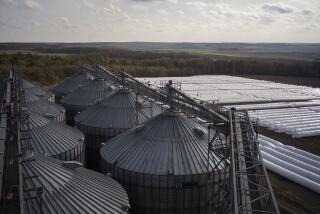China Expected to Become Top Grain Importer : Trade: The most-populous nation is fast losing its cropland. Coastal cities cannot be supplied from the interior.
- Share via
LONDON — China, the largest grain producer, will overtake Russia as the world’s leading importer by the middle of the decade.
According to market experts, China will buy more and more grain from abroad as it strives to feed a huge and growing population from a shrinking area of fertile land being gobbled up by housing and factories.
Russia’s purchases from abroad are expected to dip, however, as market reforms start to boost its farm output.
“China is the market of the future,” said Bill de Maria, chief economist at the International Wheat Council.
If Russia manages to improve its farming system and achieves its potential, it could eventually export grain again, he said.
“As Russian imports decline, China will become the major importer,” a Swiss-based grain analyst said.
China, unlike Russia, is still among the dwindling number of nations that buy grain with cash, the analysts noted.
China’s credit-worthiness and balance of payments position is much stronger than that of the former Soviet republics, said Michael Atkin, economist at the Washington-based International Finance Corp.
China’s grain imports, mostly wheat, are expected to rise sharply, to nearly 17 million metric tons in the year ending June, 1992, because of poor weather, the London-based Wheat Council forecast.
Russia, which imports both wheat and coarse grains, accounts for just over half the grain imported by the former Soviet republics--forecast at 37 million tons this season.
Chinese grain imports, especially feed grains, will increase significantly in the 1990s as meat consumption increases, Atkin says in a report on the grain trade.
Feed grains are those used to fatten the hogs that account for about 90% of the meat eaten by the Chinese.
Although China’s northern regions produce a surplus of grain, transportation problems make it cheaper for large coastal cities in the southeast, such as Shanghai, to import their supplies.
As a result, China is a net exporter of about 5 million tons of corn annually.
China has 20% of the world’s population but only 7% of the arable land, analysts said.
And an extra 100 million mouths will have to be fed by the year 2000, despite government efforts to curb the birth rate, they added.
China’s population has grown by more than 30% in the past 20 years, to 1.14 billion people.
Much of west and northwest China is desert or scrub land, fit only for livestock grazing. The desert is steadily expanding due to overgrazing and over-cultivation, and the area planted with grain grew smaller during the 1980s, analysts said, but farming reforms in the late 1970s resulted sharply increased in output.
“The Chinese are already achieving high yields through double and triple cropping. . . . They can’t get much more out of the land,” said de Maria.
But grain storage facilities could be improved and losses due to waste could be reduced, he added.
More to Read
Sign up for Essential California
The most important California stories and recommendations in your inbox every morning.
You may occasionally receive promotional content from the Los Angeles Times.













